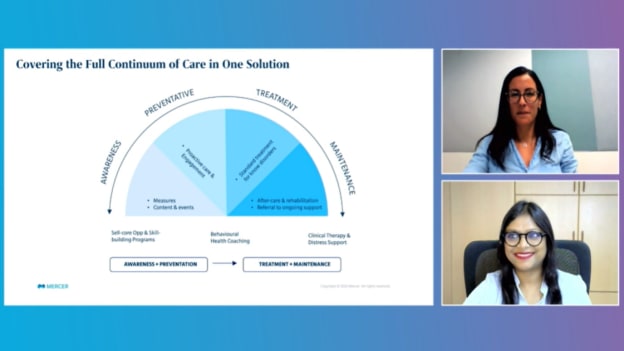The way forward for supporting mental health in the workplace

Prioritisation of mental health and wellbeing is a critical endeavour that all organisations must recognise. A collection of disparate programs carried out by HR in the name of mental wellbeing is not sufficient especially in light of the increased stress on all fronts that has been brought in by the pandemic. An important point of concern is also the continued segregation of physical and mental health when both are important key areas that contribute to the overall wellbeing of employees. It is crucial that a positive work environment that is supportive of broader emotional wellbeing of employees is created. To take this discussion further, in this session of Mercer Regional HR Conference, Liana Attard, Multinational Client Group Leader, AMEA, Mercer and Samprita Majumdar, Consultant, Global Benefits (APJ), Dell Technologies share their insights on the strategies that organisations implement to increase employee wellness, its limitations and a plan for the future.
According to a survey carried out by Mercer, it has been found that 61% of employees are looking to their employers for support to cope with workplace challenges. This in itself reveals the increasing need for mental health best practices to be incorporated both in the company’s operations and its culture. It will not only drive greater employee engagement but also bolster employee health and wellbeing and will also contribute to greater business outcomes. And while companies have been moving in the right direction through the implementation of EAP, self-help training and mindfulness tools, the impact has been limited.

Liana points out how the state of emotional wellbeing has its own continuum and organisations tend to only deliver services that cater to those with serious mental illnesses or are caught up in critical solutions. But 80% of the workforce tend to be in ‘The Well’ or ‘The At Risk’ part of the continuum. In other words, as important as intervention and treatment is and the initiative surrounding it, equally important is to focus on prevention.
Moreover, a serious disconnect is found in how care is being accessed. The issues that need care and its associated programs are found in isolation of one another with little to no connectivity. The end result is a fragmented delivery of care which manifests in confused employees, disengagement and low value of services offered by the organisation.
Samprita elaborates this further by talking about the mental health strategy being carried out at Dell. Their mental health landscape has been broadened by implementing a number of programs as part of the Dell Care Hub to cater to different focus areas of care ranging from meditation to fitness to financial wellness along with policies and practice that support flexible working as well as investing in a number of digital solutions and collaborating with daily health providers. In spite of this, engagement is low and the utilisation rate is 2% which also indicates a lack of understanding when it comes to the programs so implemented. There is fragmented delivery of multiple services with no end to end support.
At such a juncture, what can be done? Three key strategies can help develop measurable outcomes in the arena of mental health for organisations which is currently being implemented by Dell as well:
- Reduce stigma and build greater awareness: This calls for repositioning the definition of mental health, to remove its segregation from physical health and to offer a holistic program to enhance wellness and wellbeing.
- Improve accessibility: A single platform where services for prevention, intervention and treatment are offered. This creates a seamless, integrated delivery of care services.
- Build effective programs: An affordable, transparent, clear KPI is a must when building such programs. To gain insights on its popularity, usage and ROI, engagement surveys should be conducted by organisations.
From this discussion, one learns that the future for successful mental health strategies involving greater engagement and building a positive working environment demands the provision and implementation of solutions that cater to the entire spectrum of an individual’s wellbeing. Organisations have to measure ROI with targeted communication to enhance engagement with care services and offer more effective support to their workforce. Innovation is also a key factor and one must be open to collaboration, to reinvention of solutions to meet the vast array of mental health needs. But in the midst of all this collaboration and implementation, one must not lose sight of the need for an integrated approach to the delivery of care services to the workforce to make it more accessible and to drive greater engagement, enhance well being and attain business growth.
People Matters is the exclusive media partner for Mercer's 2021 Regional HR Virtual Conference.
















